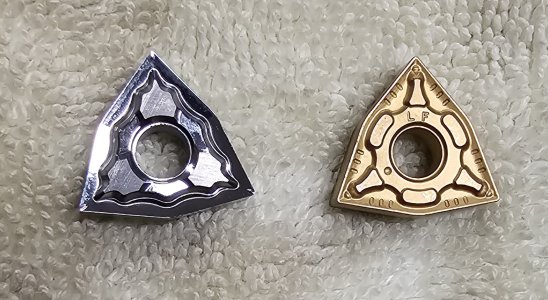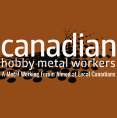I mostly turn aluminum (6061) and plastic (Delrin and some UHMW) with occasional items of 12L14 or 1144 steels. I often need short but accurate internal bores for bearings and long bores for housings and such. Also, internal threads.
That's quite a wide range of applications...... Cutting aluminium and plastic is not difficult and I can definitely see the advantages of using proper inserts that don't suffer from edge buildup.
But I think mystery steel is what gets most of us all tied up in knots. It certainly is my nemesis.
For my projects, polished positive rake inserts such a DCGT and CCGT work well.
What do you mean by polished?
I've had excellent results from the cheap eBay Chinese inserts labled as "Iscar" but almost certainly not. Prices have recently greatly increased but most of my inventory (probably sufficient for my lifetime) was purchased for less than $20/box of 10 and each insert has 4 edges so $0.50 per edge. Prices on eBay are now double or so ($1/edge). I don't think that it is reasonable to save a dollar by using HSS but then to waste 15 minutes sharpening plus having to reset tool height; your mileage may vary!
I often find this number of edges thing to be a false promise. Often the edge breaks or wears in a way that the other edges can't be used. I know I'm hard on inserts because of my mystery metal work and the frequency of interrupted cuts to clean up stock. Resetting tool height is a zero problem with a good standard. It's easy to justify using inserts on the basis of the ease of work continuation after a failure alone, and price per edge does come down fast. My favorite Trigons have 6 usable edges, but if only they really had 6 usable edges.
If you cannot tell, I have learned to use inserts, I do use inserts, and I like using inserts. I just don't recommend them as a starting point for a new machinist, and I also think this whole debate of cost is a red herring PROVIDED what you have works for what you are doing. If it doesn't work the whole cost discussion is meaningless.
It's getting there that gets you out of range cost wise. Tooling up for carbide inserts is NOT a trivial expense despite the logic that says otherwise! All these sizes, tool holders, edges, designs, point radius, coatings, anvil or shim, material targets (steel, CI, Al, hard steel, etc etc quickly add up. Multiply by the intent (RH turning, LH turning, tight corners, facing, chamfering, grooving). Plus you normally have to buy 10 of each for each. Worse, when it doesn't work, a newbie has no idea why. Getting help is NOT trivial.
As I said, I am getting there myself. But it wasn't an easy trip and I'm still not fully there yet. As I write this, I'm still mud wrestling with insert threading. It's sooooo confusing. I've been single point threading with HSS for 40 years. I'm darn good at it. I can only begin to imagine what it would have been like if I had started with Carbide Inserts.
For boring I use Chinese solid carbide boring bars with CCGT inserts. The carbide boring bars are more rigid than steel ones and that is essential for a 1/2-inch bore 3 inches long. I'm uncertain how one would substitute HSS.
Most of my boring bars are steel with inserts too.
But I'm not above using solid carbide, or steel bars with small 1/4 or 1/8 HSS Bits.
I'm also not above drilling and reaming.
But my goto is steel with inserts.
Things get more and more interesting as the hole diameter gets smaller and the depth gets deeper.
IMHO, boring small deep holes is NOT beginner territory. Better to drill and ream if you can. If you can't, ANUSOL helps.
I agree that a bump knurler is not really suitable for a light lathe such as a Myford. Hemingway Kits have a rather nice scissor type that is specifically Myford sized.
Right on.
Or maybe a cut knurler would be a good project.
A cut knurler is on my ToDo list. Not sure making one is a good newbie project though. I don't know how well they work on smaller lathes. @Mcgyver @gerritv?




